
Okapi
Okapi
Okapi
Have you ever heard of Okapi, one of the world's three most rare animals? Okapi has a zebra-like stripe pattern, but it is actually a mysterious animal called a member of the giraffe family. Okapi is an interesting animal that has only been discovered for about 100 years, and there are still many things we don't understand. Let's take a sneak peek at what features and secrets Okapi has in this article!
Okapi Basic Infomation

Cetartiodactyla-Giraffidae-Okapi genus.
Male length:1.9~2.5m weight:220~300kg. Female length:1.9~2.5m weight:280~350Kg.
Okapi's habitat is the rainforest around Gabon, the Democratic Republic of the Congo in Central Africa.
The ecology of okapi in the wild is still largely unknown, as they tend to prefer to live in forests with dense trees. In general, the body tends to be larger in females and smaller in males.
Okapi are basically animals that live alone, and both males and females live alone except during the breeding season or when they have children.
When the female okapi reaches the breeding season, she uses the smell and sound of pee to let the male know her whereabouts. Okapi gives birth to only one child after about 14 months of pregnancy.
Okapi is a herbivorous animal that feeds mainly on tree leaves, not on plants that grow on the ground.They use their long tongues to dexterously roll up leaves, branches, and young shoots, and eat as much as 18-29 kg of plants a day.
It is said that they eat more than 100 kinds of plants in the wild, but they sometimes eat fruits and mushrooms as well as leaves and branches of trees. They have also been seen eating mud near the river to replenish minerals.
Okapi Q&A

What is the origin of Okapi's name?
Okapi was officially discovered and its existence announced in 1901 by "Harry Johnston", an English explorer.
Harry Johnston was intrigued by rumors that there was an animal that resembled a horse, which the indigenous pygmy called an "okapi," so he conducted a survey.
The word okapi means "horse of the forest" in the pygmy language, and this animal came to be called okapi as it is.
By the way, Okapi is sometimes called the "lady of the forest" because of the beautiful pattern on her feet.
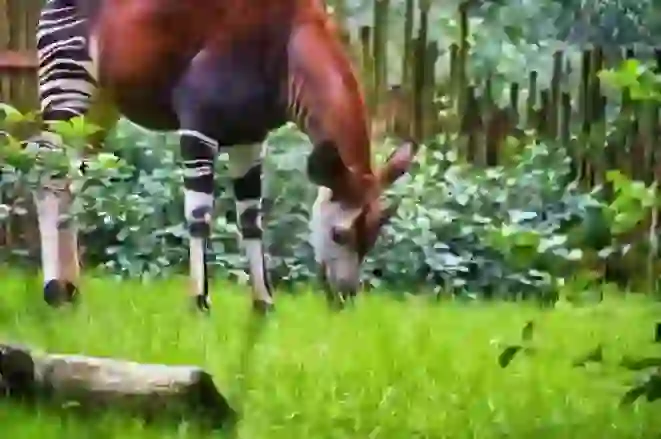
Is it true that Okapi is one of the giraffes?
The giraffe has an impressively long neck, but Okapi's neck is not as long as the giraffe's.
Also, okapi does not have a giraffe-like pattern, but rather a zebra-like pattern. So is Okapi really one of the giraffes? Some people may think so.
In fact, when Okapi was first discovered, it was thought to be a member of the zebra family, not a giraffe.
However, upon closer examination, I found that Okapi has two hooves.If Okapi were truly a member of the horse fellow, he would have only one hoof.
Therefore, we found out that Okapi is not a member of the horse fellow, but a member of the "Cetartiodactyla" family, which is similar to cattle.(Giraffes are cetartiodactyla.)
In addition, many similarities between okapi and giraffes were discovered, such as the fact that males of okapi have antlers wrapped in hair, long tongues, and similar tooth structures, and it turned out that okapi is a member of the giraffe fellow and the closest animal to giraffes.
Incidentally, okapi live in the rainforest and giraffes live in the savannah, so their habitats do not overlap.
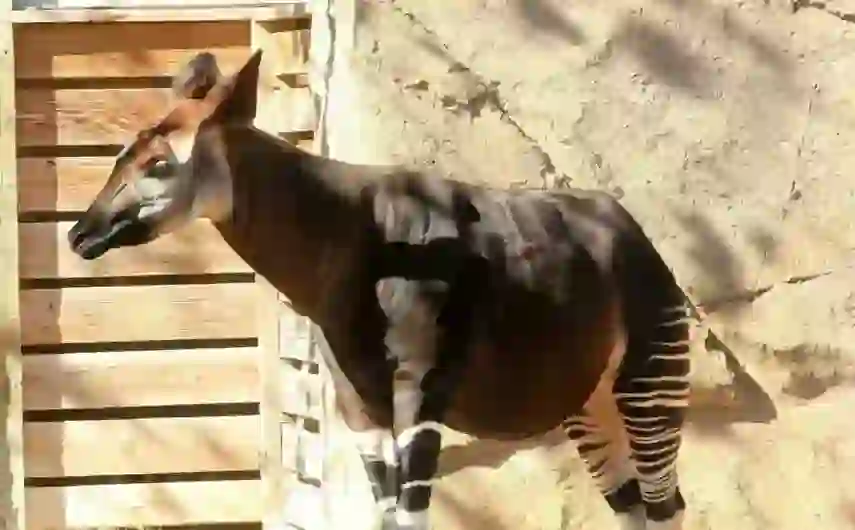
Why are okapi said to be a rare beast?
Okapi is called one of the "three most rare animals in the world" along with "pygmy hippopotamus" and "giant Panda" as a very rare animal. So why is the okapi said to be a rare animal?
The reason for this is that their habitat is very limited, their population is small, and they have survived for a long time without changing their appearance.
In addition, despite the fact that okapi is a large animal weighing as much as 300 kg, it was finally discovered in the 20th century, and the fact that we know very little about its life in the wild is another reason why it is said to be rare.
Incidentally, the ancestors of the okapi and the giraffe were the same animal, and like the okapi, the animal did not have a long neck and lived in the forest.
After that, the giraffe moved from the forest to the grassland and began to eat the leaves of trees higher up, and it is thought that the giraffe's neck grew longer and longer and became what it is today. Okapi, on the other hand, is thought to have survived in the forest for about 10 million years without changing its appearance or life, and is sometimes referred to as "living fossil," "giraffe whose head did not grow," or "giraffe of the forest.
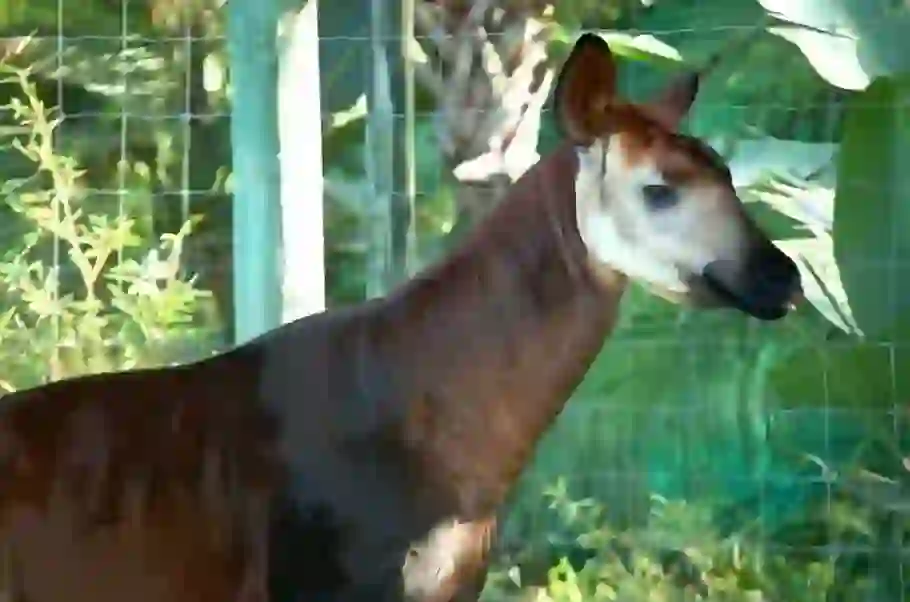
Why is Okapi's tongue so long?
The tongue of an okapi is very long, about 40-50 cm long, just like a giraffe. It is thought that okapi and giraffes may have evolved their tongues longer to eat the leaves of trees at high altitudes.
In addition, the surface of Okapi's tongue is rough and file-like so that it can securely roll up the leaves of the tree. Therefore, it is quite painful to be licked by okapi, and it also has a unique smell.
By the way, Okapi uses his long tongue for many things, not just for eating. They lick and clean their own bodies, remove garbage from their eyes and nose, or drive away insects, as if they were our hands or fingers.
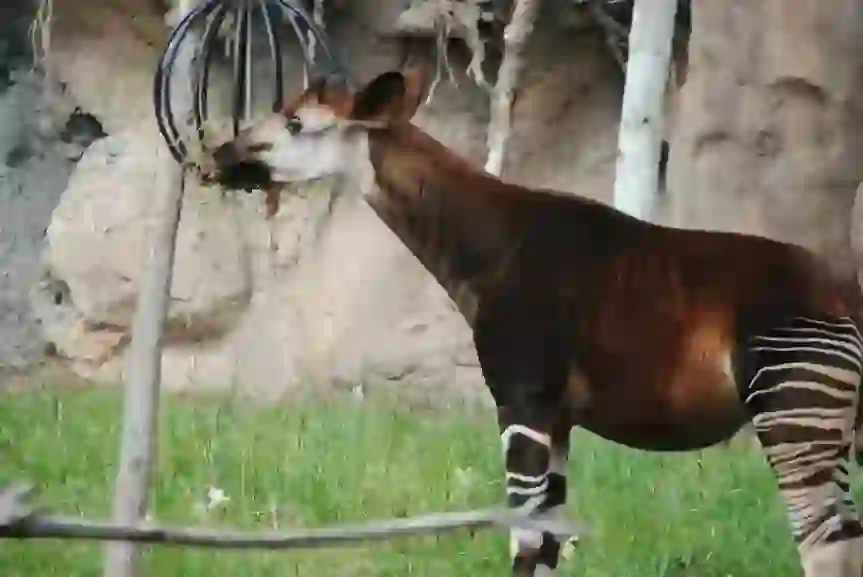
Why is Okapi squirming his mouth?
This is because the okapi digests and absorbs the grass it eats, a behavior called rumination.
Animals that ruminate, such as okapi, are called "ruminants".
After eating a plant, ruminants repeatedly return the contents of their stomachs to their mouths, chew them, and swallow them.
This is called rumination, in which the plants you eat are crushed into small pieces and mixed with saliva to digest and absorb the food.
Ruminants have four stomachs, and they have a lot of microorganisms in their stomachs.
Rumination allows the microorganisms in the stomach to break down the plants and produce the nutrients that the body needs. This is why okapi and giraffes can grow so big even though they only eat grass.
By the way, rumination can also be seen in cows, goats, and camels.
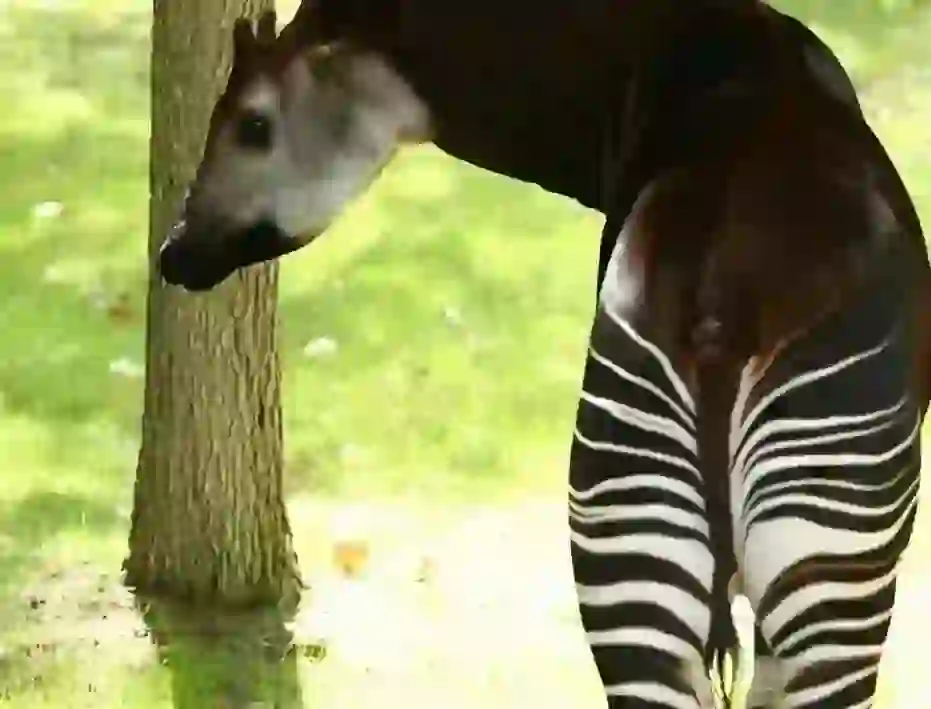
What do the okapi at the zoo eat?
Zoo okapi eat leafy branches, hay (pasture), pellets for herbivores, and bananas.
The leaves are made from a variety of plants that can be obtained in each season (such as quercus serrata, arakashi, kunugi, willow, glossy privet, and shirakashi).
Okapi eats more than 20 kg of food a day, so it takes a lot of effort just to prepare daily meals.

What does the Okapi stripe pattern mean?
It is said that the striped pattern of okapi, which looks flashy at first glance, actually plays a role in camouflage. In a dark forest with trees, Okapi's brown to blackish brown body color and pattern become a protective color, deceiving the eyes of his natural enemies. It is also thought that Okapi's children may recognize their own mothers by looking at these stripes.

How does Okapi feel to the touch?
Okapi's hair is as it appears, velvety, fluffy, soft, and smooth to the touch. Okapi seems to be very particular about taking care of his hair, and he often uses his long tongue to lick his entire body to take care of it.
Okapi hair is a little greasy on the surface and repels water. It is thought that this is because the tropical rainforest where okapi lives has a lot of rain throughout the year, and it rains heavily, called squalls.
When many animals get their bodies wet in the rain (water), they lose their body heat and are more likely to get sick.
If wild animals get sick, they are more likely to be targeted by their natural enemies, so okapi may be taking good care of their hair on a daily basis to protect themselves.

How long will Okapi live?
The lifespan of an okapi is thought to be about 15 to 22 years. The longest-lived animal in captivity was okapi, a male born in the Netherlands, who lived to be 33 years old and 6 months old.
By the way, the okapi that lives the longest in Japan is the grandpa okapi "Kianga" at the Kanazawa Zoo in Kanagawa Prefecture, known as the okapi that came to Japan (Asia) for the first time. Kianga, who turned 24 in 2020, is breaking the record by surpassing the lifespan of the female okapi who was at the Ueno Zoo in Japan until 2019. I hope they live longer and break even more records.

What enemies does Okapi have?
The natural enemy of okapi in the wild is said to be the leopard, a carnivore of the felidae.
Okapi listens carefully to the sounds around him with his large ears to avoid meeting his natural enemies.
But for okapi, the biggest enemy is us humans.
Okapi was designated as a protected animal by the then Zaire government in 1993, and in 1996, a protected area called the "Okapi Wildlife Sanctuary was established".
In addition, it has been designated as an endangered species on the red list, and is an animal that is heavily protected both nationally and internationally.
Okapi has always had a limited habitat, and its habitat is a tropical rainforest with many trees. However, in the areas where okapi lives, slash-and-burn agriculture and deforestation are taking place, and the number of tropical rainforests where okapi can live is decreasing rapidly.
In addition, in recent years, tropical rainforests have been developed to collect rare metals (gold, diamonds, coltan, etc) used in precision devices such as smartphones.
As if to add insult to injury, the area where okapi lives is still in conflict, and there is no end to the poaching that targets the fur and meat of okapi. At this rate, the number of okapi is decreasing rapidly, and there is a concern that they will eventually become extinct.

Would you like to become a part of the 'Animalbook.jp'?
Turn your knowledge into Q&A and share it with the world. ※Publication will be activated after purchase. Let's share information together!
Okapi Type of List

- Okapi
Information
Congratulations! You are the first commenter!

Create Your Favorite List!
Okapi
Save the animals you love! Build your own list to quickly revisit your favorites later.

Would you like to leave a comment?
※Please note: This is for the purchase of rights to post comments within the article.
Find Your Favorites!
Our shop offers a unique and attractive selection of goods themed around various animals.
Okapi References

- 今泉 吉典(1986年)『動物大百科4 大型草食獣』平凡社
- スミソニアン協会(2017年)『驚くべき世界の野生動物生態図鑑』日東書院本社
- 東京ズーネット「珍獣オカピ」 https://www.tokyo-zoo.net/topics/profile/profile09.shtml
- 上野動物園[公式]Twitter(@UenoZooGardens ) https://x.com/UenoZooGardens/status/1317636215990988801
- いしかわ動物園「アニマルあいズ 2013春vol14-1」 http://www.ishikawazoo.jp/eyes/pdf/animaleyes14-1.pdf
- 金沢自然公園 金沢動物園「キィァンガ お誕生日おめでとう」 http://www.hama-midorinokyokai.or.jp/zoo/kanazawa/details/post-1156.php
- SAN DIEGO ZOO「Okapi」 https://animals.sandiegozoo.org/animals/okapi
- 毎日新聞「アニマル・ワールド オカピ」 https://mainichi.jp/articles/20151219/kei/00s/00s/003000c
- ハマトク「"アイドル"オカピに会いに行く」 https://hama-toku.jp/yokokana/sp09/
- 横浜市緑の協会「オカピは何のなかまかな?」 http://www.hama-midorinokyokai.or.jp/zoo/zoorasia/files/0805work_3.pdf
- 産経ニュース「生きた化石 首が伸びなかったキリン」 https://www.sankei.com/life/news/160822/lif1608220017-n1.html
- 旭化成ホームズ「川口先生のペットコラム おもしろ哺乳動物大百科112(偶蹄目(クジラ偶蹄目)キリン科)」 https://www.asahi-kasei.co.jp/hebel/pet/kenkyu/blog/2015.04-2015.09.shtml/
Okapi Introduction of media used

出典:https://pixabay.com/images/id-1721087/

出典:https://unsplash.com/photos/710etVkWfFQ

出典:https://pixabay.com/images/id-347255/
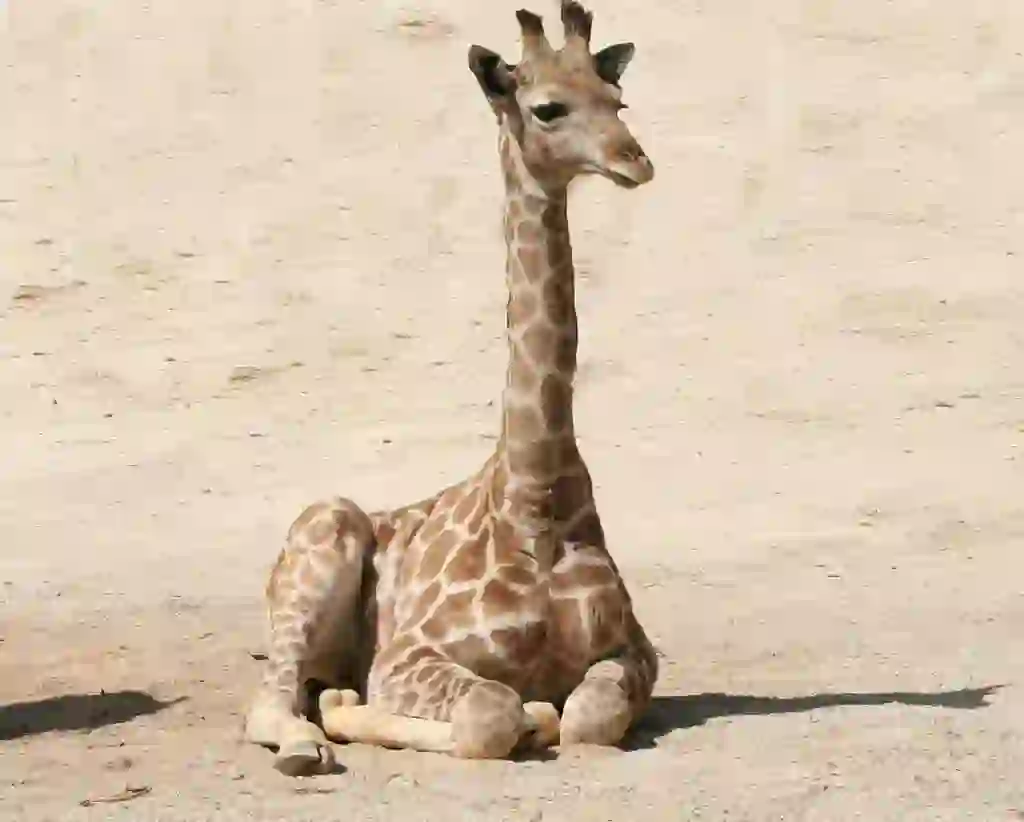
similar
出典:https://pixabay.com/images/id-1024589/

出典:https://pixabay.com/images/id-2127389/

出典:https://pixabay.com/images/id-676795/

出典:https://pixabay.com/images/id-1845086/

enemy
出典:https://pixabay.com/images/id-694460/

enemy
出典:https://pixabay.com/images/id-405749/

Help Enrich Our Animalbook.jp with Your Media!
We are constantly looking to expand and enrich our Animalbook.jp with amazing photos and videos of animals. If you have any media that you'd like to share, please contribute and help us showcase the beauty and diversity of the animal kingdom. Your submissions will be credited and featured in our encyclopedia, reaching a wide audience of animal lovers.


















